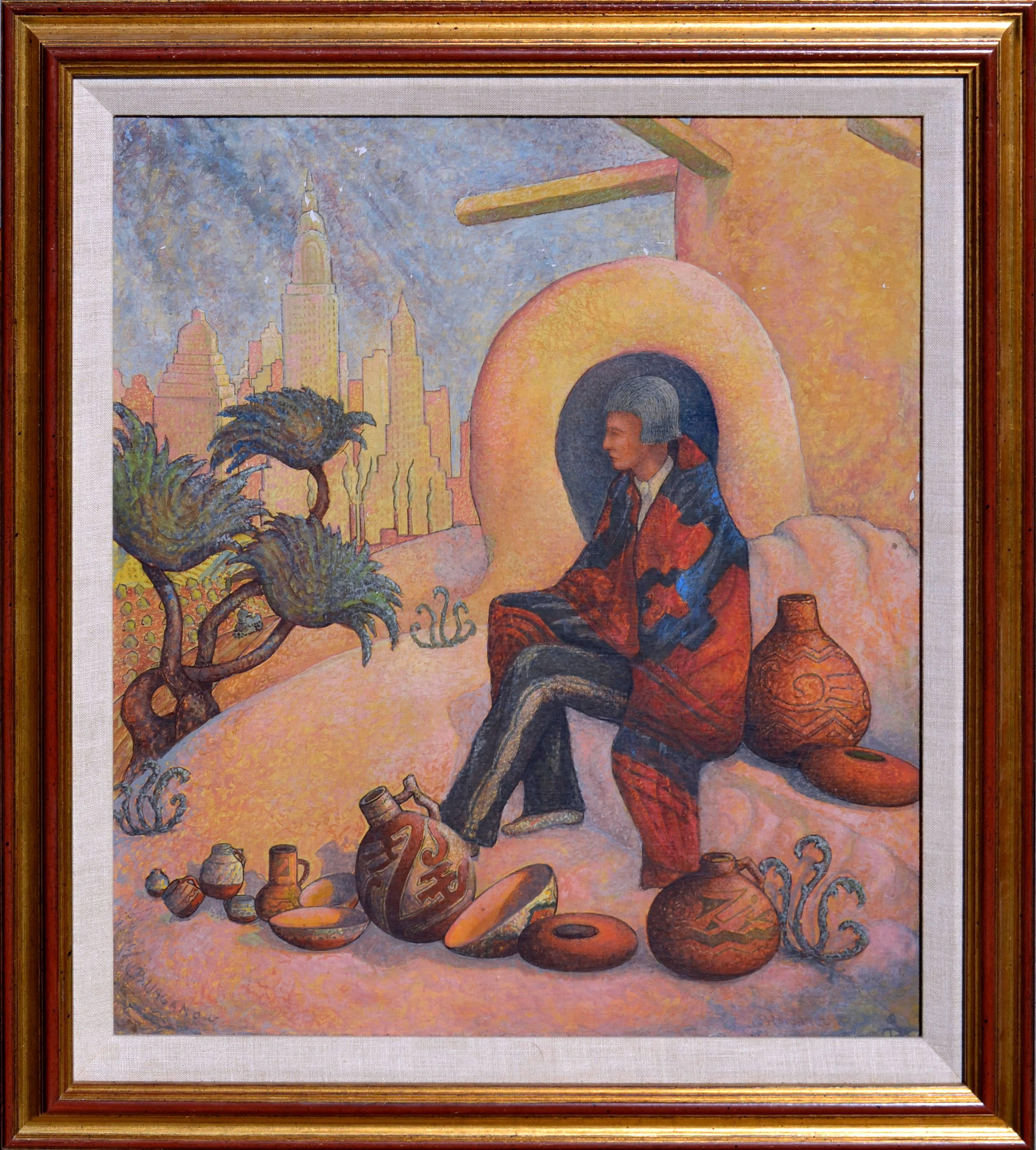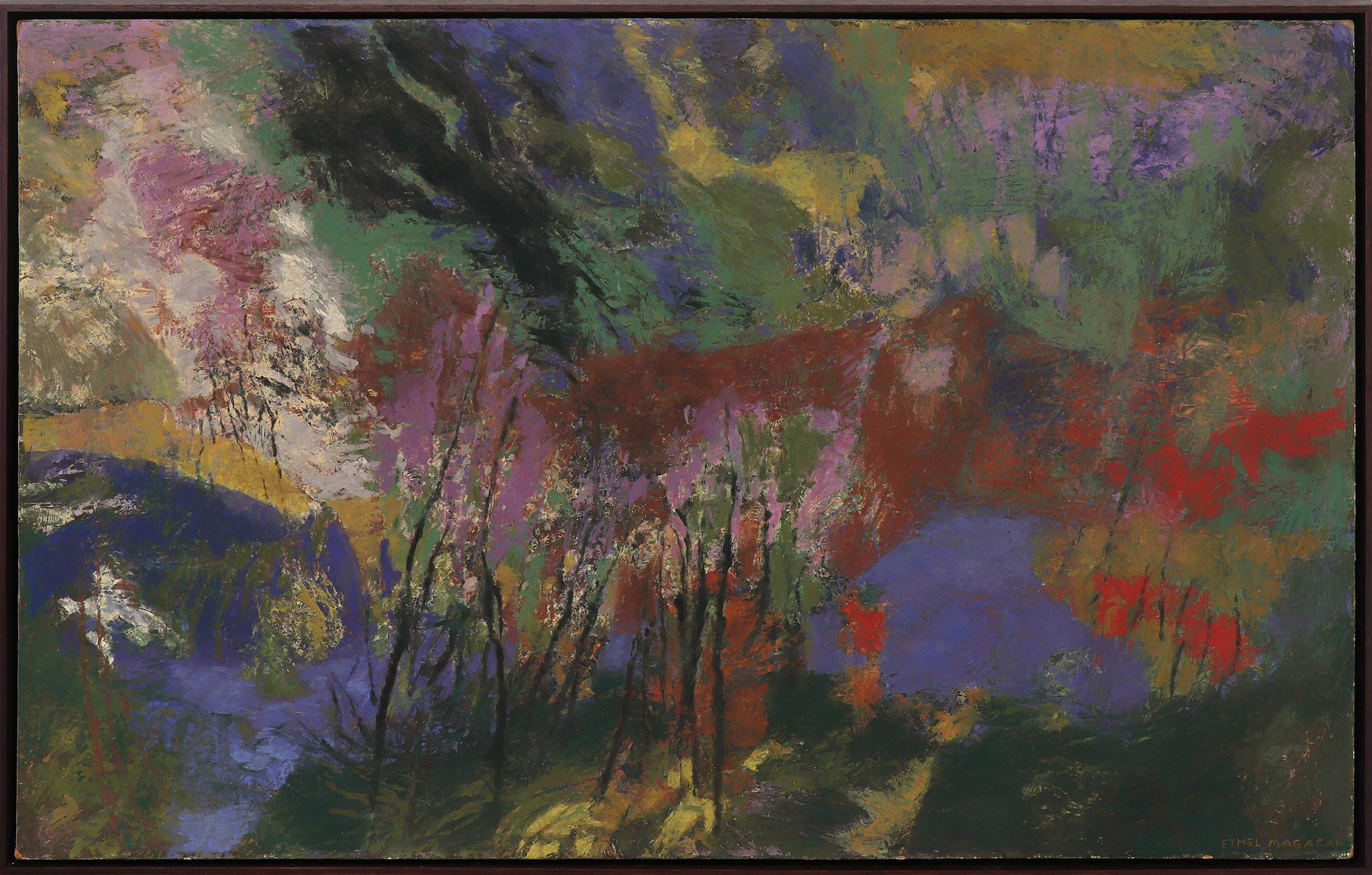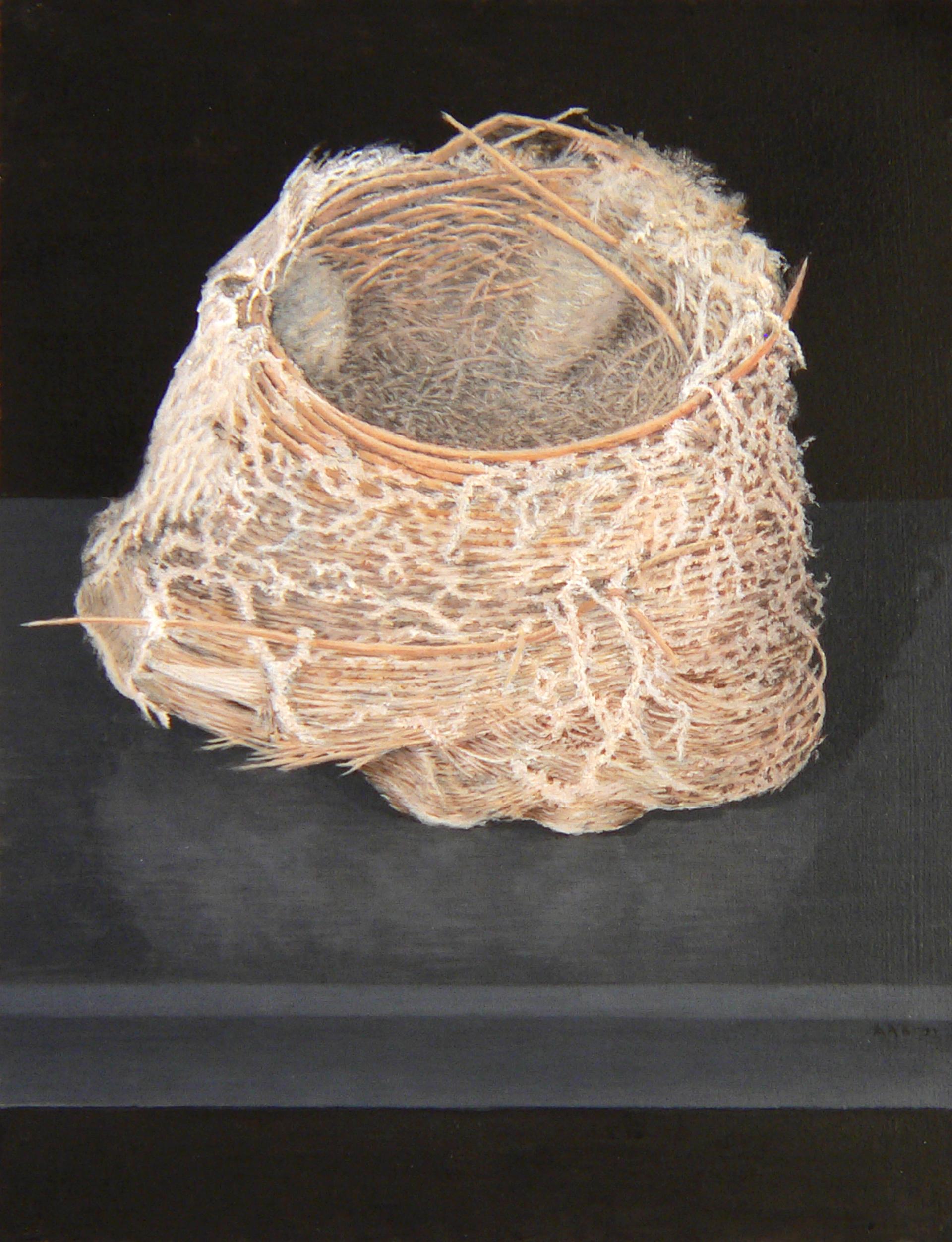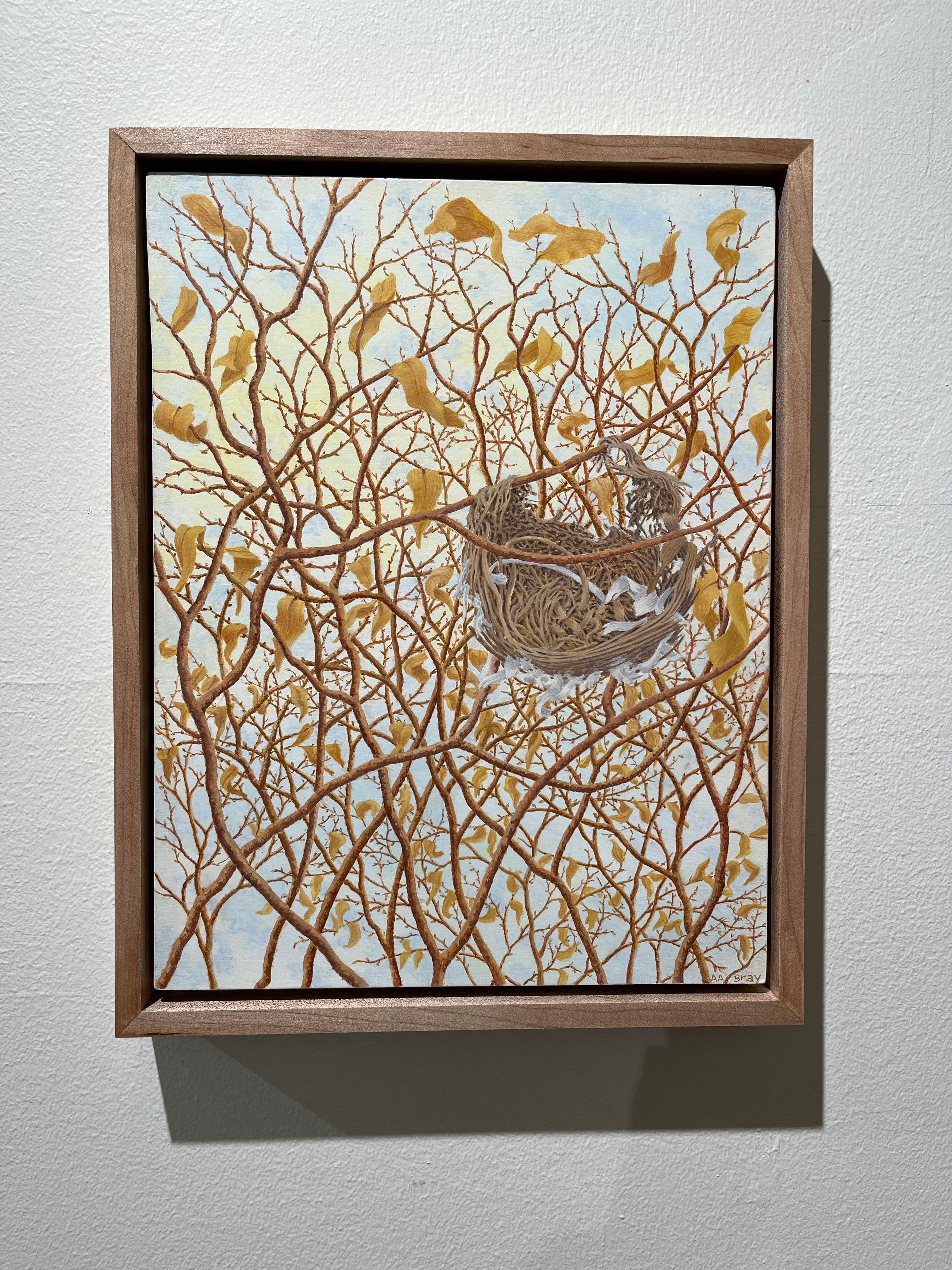Items Similar to Pikes Peak, 1940s Colorado Mountain Landscape in Autumn, Tempera Painting
Video Loading
Want more images or videos?
Request additional images or videos from the seller
1 of 16
Charles Ragland BunnellPikes Peak, 1940s Colorado Mountain Landscape in Autumn, Tempera Painting1941
1941
About the Item
Original vintage 1941 Colorado landscape painting with autumn leaves and Pikes Peak blanketed in snow by Charles Bunnell (1897-1968). Inscribed verso, "To Laura, November 22, 1941", egg tempera on board. Signed by the artist in the lower left corner and titled verso. Presented in a custom frame, outer dimensions measure 15 ½ x 19 ¼ x 1 ¼ inches. Image size is 7 ¾ x 11 inches
About the Artist:
Artist and teacher, Charles ("Charlie") Bunnell worked in a variety of styles throughout his career because as an artist he believed, "I’ve got to paint a thousand different ways. I don’t paint any one way." At different times he did representational landscapes while concurrently involved with semi- or completely abstract imagery. He was one of a relatively small number of artists in Colorado successfully incorporating into their work the new trends emanating from New York and Europe after World War II. During his lifetime he generally did not attract a great deal of critical attention from museums, critics and academia. However, he personally experienced a highpoint in his career when Katherine Kuh, curator at the Art Institute of Chicago, personally chose one of his paintings - Why? - for its large exhibition of several hundred examples of abstract and surrealist art held in 1947-48, subsequently including it among the fifty pieces selected for a traveling show to ten other American museums.
An only child, Bunnell developed his love of art at a young age through frequent drawing and political cartooning. In high school he was interested in baseball and golf and also was the tennis champion for Westport High School in Kansas City. Following graduation, his father moved the family to Denver, Colorado, in 1916 for a better-paying bookkeeping job, before relocating the following year to Colorado Springs to work for local businessman, Edmond C. van Diest, President of the Western Public Service Company and the Colorado Concrete Company. Bunnell would spend almost all of his adult life in Colorado Springs.
In 1918 he enlisted in the United States Army, serving in the 62nd Infantry Regiment through the end of World War I. Returning home with a 10% disability, he joined the Zebulon Pike Post No. 1 of the Disabled American Veterans Association and in 1921 used the benefits from his disability to attend a class in commercial art design conducted under a government program in Colorado Springs. The following year he transferred to the Broadmoor Art Academy (founded in 1919) where he studied with William Potter and in 1923 with Birger Sandzén. Sandzén’s influence is reflected in Bunnell’s untitled Colorado landscape (1925) with a bright blue-rose palette.
For several years thereafter Bunnell worked independently until returning to the Broadmoor Art Academy to study in 1927-28 with Ernest Lawson, who previously taught at the Kansas City Art Institute where Bunnell himself later taught in the summers of 1929-1930 and in 1940-41. Lawson, a landscapist and colorist, was known for his early twentieth-century connection with "The Eight" in New York, a group of forward-looking painters including Robert Henri and John Sloan whose subject matter combined a modernist style with urban-based realism. Bunnell, who won first-place awards in Lawson’s landscapes classes at the Academy, was promoted to his assistant instructor for the figure classes in the 1928-29 winter term. Lawson, who painted in what New York critic James Huneker termed a "crushed jewel" technique, enjoyed additional recognition as a member of the Committee on Foreign Exhibits that helped organize the landmark New York Armory Exhibition in 1913 in which Lawson showed and which introduced European avant-garde art to the American public.
As noted in his 1964 interview for the Archives of American Art in Washington, DC, Bunnell learned the most about his teacher’s use of color by talking with him about it over Scotch as his assistant instructor. "Believe me," Bunnell later said, "[Ernie] knew color, one of the few Americans that did." His association with Lawson resulted in local scenes of Pikes Peak, Eleven Mile Canyon, the Gold Cycle Mine near Colorado City and other similar sites, employing built up pigments that allowed the surfaces of his canvases to shimmer with color and light. (Eleven Mile Canyon was shown in the annual juried show at the Carnegie Institute in Pittsburgh in 1928, an early recognition of his talent outside of Colorado.) At the same time, he animated his scenes of Colorado Springs locales by defining the image shapes with color and line as demonstrated in Contrasts (1929). Included in the Midwestern Artists’ Exhibition in Kansas City in 1929, it earned him the gold medal of the Kansas City Art Institute, auguring his career as a professional artist.
In the 1930s Bunnell used the oil, watercolor and lithography media to create a mini-genre of Colorado’s old mining towns and mills, subject matter spurned by many local artists at the time in favor of grand mountain scenery. In contrast to his earlier images, these newer ones - both daytime and nocturnal -- such as Blue Bird Mine essentially are form studies. The conical, square and rectangular shapes of the buildings and other structures are placed in the stark, undulating terrain of the mountains and valleys devoid of any vegetation or human presence. In the mid-1930s he also used the same approach in his monochromatic lithographs titled Evolution, Late Evening, K.C. (Kansas City) and The Mill, continuing it into the next decade with his oil painting, Pikes Peak (1942).
During the early 1930s he studied for a time with Boardman Robinson, director of the Broadmoor Art Academy and its successor institution, the Colorado Springs Fine Arts Center from 1930 to 1947. In 1934 Robinson gave him the mural commission under the Public Works of Art Project (PWAP) for West Junior High School in Colorado Springs, his first involvement in one of several New Deal art projects employing artists during the Great Depression. He thereafter assisted Frank Mechau with his mural for the Colorado Springs Post Office and Mechau, in turn, helped get him transferred to the Treasury Relief Art Project (TRAP) that commissioned work from artists to decorate existing and new federal buildings throughout the country. When it closed down due to lack of funds, Bunnell participated in the Federal Art Project (FAP) for which he did easel paintings in the proscribed American Scene painting style.
At the same time, he also began working on his own in a non-regionalist style that evolved into full-blown abstraction by the early 1950s. One indication of the new direction, a drawing - Evolution of Art (1937), shows three warheads breaking down various barriers in their path to make way for new developments in art. It may have been inspired by a traveling exhibition of abstract art which he saw at the Colorado Springs Fine Arts Center in 1936. Another shift toward abstraction was his Black and Blue watercolor series of eighty-three ink and watercolors begun in 1936 and pursued through the 1940s.
As described by Dord Fitz, Bunnell’s friend, gallery owner and dealer based in Amarillo, Texas, the Black and Blue Series "presents a world of the spirit where all men are one… [Bunnell] carries the spectator into a spiritual realm which remains undisturbed by the colossal misunderstandings which plague a life dominated by material and physical things." Fitz also noted that the series blends "the various feelings concerning theories of Existence - Buddha, Christ, Lao Tze, Confucius and Mohammed. All become One." The series mirrors Bunnell’s personal spiritual journey extending into the late 1950s reflected in his art. The loss of his 10-year old son, Lee, in 1938, and the death and destruction caused by World War II also found expression in the series, as well as in his moody surrealist pieces from the mid-to-late 1940s, such as the Bird of Doom watercolors and a set of the seven deadly sins.
The geometric shapes of his earlier representational work reappeared in the 1950s in the form of roughly- rendered rectangles, squares and triangles in various sizes and colors in his pure abstractions, such as an untitled composition (1951) of small, massed geometric shapes in an impasto surface highlighted in bright red, blue and green. By mid-decade his palette became a little more subdued with larger shapes dominating the canvas, as in Artist and His Pictures (1955), and Progression (1956) with its superimposed clusters of smaller geometric shapes. These and other similar abstract paintings constitute the highlight of his career during which, in the words of Al Kochka -- curator of Bunnell’s posthumous retrospective (1987) at the Amarillo Art Center - "he never ceased to experiment and expand his visual language."
In the artist’s statement for the catalog of his exhibition at the Colorado Springs Fine Arts Center in 1956, Bunnell said of his work: "Art to me is a search: in other words, a way of living, have painted for thirty-five years going through many phases from realism and portraiture to, I feel, advanced modern concepts, where the observer can, by looking at my paintings, become a creator as well as I. In other words, each viewer can see what he feels in my work."
Bunnell continued to teach throughout most of his career. Having briefly taught art classes toward the end of the Federal Art Project during the Depression era, he began conducting classes in his own Colorado Springs studio in 1949. He continued mentoring new artists until the last years of his life before succumbing to emphysema. In the 1950s he was one of the artists Dord Fitz attracted to teach and display his work in Amarillo, along with Louise Nevelson, James Brooks, Leon Polk Smith and Elaine de Kooning, among others. In 1960 de Kooning painted Bunnell’s portrait, now in a private collection. ©Stan Cuba for David Cook Galleries, LLC
Solo Shows: Kansas City Art Institute (1930); New Mexico Museum of Art-Santa Fe (1947); University of Illinois-Urbana (1948); University of Kentucky, Lexington (1949); Taos Gallery-New Mexico (1951); Carl Barnett Galleries-Dallas (1952); The Antlers Gallery-Colorado Springs (1952); Bodley Gallery-New York (1955); Haigh Gallery-Denver (1955); Colorado Springs Fine Arts Center (1956); Dord Fitz Gallery-Amarillo, TX (1956, 1957, 1959. 1969-retrospective).
Group Exhibitions: Colorado State Fair (1928, first prize); Carnegie International-Pittsburgh (1928); Denver Art Museum (1928, 1947,1956); Artists Midwestern Exhibition-Kansas City, MO (1929, gold medal-first prize); Colorado Springs Fine Arts Center-show with Archie Musick sponsored by Randall Davey (1930); World’s Fair Art Exhibition-San Francisco (1939); Art Institute of Chicago-"Abstract and Surrealist Art" (1947-48); Colorado Springs Fine Arts Center-"Artists West of the Mississippi" (1936, 1941, 1946, 1948, 1953, 1959); Mid-America Annual, Kansas City, MO (1958); First Provincetown Festival-MA (1958); Southwestern Annual-Santa Fe (1957-58).
- Creator:Charles Ragland Bunnell (1897-1968, American)
- Creation Year:1941
- Dimensions:Height: 15.5 in (39.37 cm)Width: 19.25 in (48.9 cm)Depth: 1.25 in (3.18 cm)
- Medium:
- Movement & Style:
- Period:
- Framing:Frame IncludedFraming Options Available
- Condition:very good vintage condition.
- Gallery Location:Denver, CO
- Reference Number:
About the Seller
5.0
Platinum Seller
These expertly vetted sellers are 1stDibs' most experienced sellers and are rated highest by our customers.
Established in 1979
1stDibs seller since 2013
264 sales on 1stDibs
Typical response time: 5 hours
- ShippingRetrieving quote...Ships From: Denver, CO
- Return PolicyA return for this item may be initiated within 7 days of delivery.
More From This SellerView All
- Springtime, 1960s Semi Abstract Modernist Mountain Landscape Tempera PaintingBy Ethel MagafanLocated in Denver, CO"Springtime" is an original tempera on board painting of a Colorado mountain landscape painting by Ethel Magafan circa 1960. Abstracted mountain landscape with trees, painted in colors of green, purple, golden yellow, red, orange, blue, black and white. Presented in a custom hardwood frame, outer dimensions measure 23 ¼ x 50 x 2 inches. Image size is 30 x 48 inches. Provenance: Private collection, Maine Acquired in the early 1960s, by descent through the family to the present owner About the Artist: Jenne and Ethel Magafan were identical twins, born in Chicago to a Greek immigrant father and a Polish mother. Due to health concerns about their father, the family moved to Colorado, living first in Colorado Springs and then in Denver. He was a proud supporter of their artistic ambitions but died suddenly 1932, a heavy blow to both of them. They attended East High School in Denver, where they found a mentor in their art teacher Helen Perry. She had studied at the Art Institute of Chicago but had later abandoned a career as an artist, making her all the more determined to help the Magafan twins succeed artistically. While still in high school, the twins impressed artist Frank Mechau, and Helen Perry paid for their lessons with him. He subsequently invited them to apprentice with him at his Redstone studio. In 1936, Jenne won the Carter Memorial Art Scholarship and shared it with her sister so that they both could attend the Broadmoor Art Academy in Colorado Springs. Once they ran out of money, Mechau, now teaching there, hired them as assistants. Through their involvement at the Academy, the twins entered into careers as muralists, working at first with Mechau and then with Peppino Mangravite. From 1937 to 1943, Ethel was commissioned to paint her first of seven government sponsored murals. Located in the US Post Office in Auburn, Nebraska, this commission made Ethel (at age 26) the youngest artist in America to receive such an honor. Denver Art Museum director Donald J. Bear once commented that “[Ethel and Jenne's] study of local detail makes them appear as little Bruegels of ranch genre – natural and unforced.” As mural painting commissions diminished, Ethel began to do more easel painting for which she used a palette knife and tempera paints to great effect. After settling in California for five years, the twins permanently relocated to Woodstock, New York in 1945, where the sisters lived apart for the first time. Ethel developed an increasing focus within her work, particularly for horses and abstract landscapes. She met fellow artist Bruce Currie...Category
Mid-20th Century American Impressionist Abstract Paintings
MaterialsTempera, Board
- Capitola, California, 1950s Framed California Seascape Marine Oil PaintingBy Jon BlanchetteLocated in Denver, COCapitola (California) is an oil on board painting by Jon Blanchette (1908-1987) circa 1955. Marine seascape painting with crashing waves and buildings along the coast painted in shad...Category
1950s American Impressionist Landscape Paintings
MaterialsBoard, Oil
- Colorado Mountain Town, Original Vintage 1920s-1930s Painting, MountainsBy Adma Green KerrLocated in Denver, COColorado Mountain Town, original, vintage signed painting by early Colorado woman artist Adma Green Kerr (1878-1949). Painted in the 1920s-1940s, the sc...Category
20th Century American Impressionist Landscape Paintings
MaterialsBoard, Oil
- 1920s Colorado Landscape Painting, Framed Western Oil Painting, Sky and ButtesBy Charles Ragland BunnellLocated in Denver, COOriginal vintage 1926 signed and framed Landscape Painting by Charles Ragland Bunnell (1897-1968), painted while the artist was studying under Ernest Lawson at the Broadmoor Academy ...Category
1920s American Impressionist Landscape Paintings
MaterialsBoard, Oil
- 1930s Summer Landscape Oil Painting, Framed Mountain Landscape Rocks Trees HouseLocated in Denver, COOil on board painting by Sister Mary Norbert from 1938 of a summer mountain landscape with lush trees and a farm house. Colors of green, brown, purple, blu...Category
1930s American Impressionist Landscape Paintings
MaterialsBoard, Oil
- Cabin Near Estes Park, Colorado, 1920s Landscape Oil Painting, Green Blue, GrayBy Randall DaveyLocated in Denver, COOriginal oil on board painting by artist Randall Vernon Davey (1887-1964) painted circa 1927. Painting depicts a wood cabin near Estes Park, Colorado. Mt. Meeker, Long's Peak, and La...Category
Mid-20th Century American Impressionist Landscape Paintings
MaterialsBoard, Oil
You May Also Like
- Once The Master - Mid Century Figurative LandscapeBy Benjamin G. VaganovLocated in Soquel, CAOnce The Master - Mid Century Figurative Landscape "Once the Master" a portrait of a Zuni Master Potter in contrast with the emergent modernism around him. He is beneath an adobe an...Category
1950s American Impressionist Figurative Paintings
MaterialsLinen, Egg Tempera, Cardboard
- Old Mill Point, Cape Cod, MassLocated in Milford, NHA fine naive landscape painting with a windmill by American artist Janet Munro (b. 1949). Munro was born in Woburn, MA, and her work focuses on the waterfront lives of everyday peopl...Category
1980s American Impressionist Landscape Paintings
MaterialsOil, Egg Tempera, Board
- AS THE DAYS WASH OVER ME Egg Tempera 12 x 24 Portraiture Finalist PSABy E. Melinda MorrisonLocated in Houston, TXAS THE DAYS WASH OVER ME‐ BY E. Melinda Morrison is egg tempera on a prepped aluminum panel This egg tempera paintings is 12 x 24 is painted by E. Melinda Morrison in her studio wh...Category
2010s American Impressionist Figurative Paintings
MaterialsEgg Tempera
- Alan Bray, Nest in a Nest, 2023, impressionist casein nature nest paintingBy Alan BrayLocated in New York, NYThe latest painting from Alan Bray is a rare and exotic sighting, indeed. He’s shifted his focus away from the human realm and up to the skies, capturing an empty bird’s nest camoufl...Category
2010s American Impressionist Landscape Paintings
MaterialsCasein, Panel
- Alan Bray, Windblown, 2023, impressionist casein nature nest paintingBy Alan BrayLocated in New York, NYThe latest painting from Alan Bray is a rare and exotic sighting, indeed. He’s shifted his focus away from the human realm and up to the skies, capturing an empty bird’s nest camoufl...Category
2010s American Impressionist Landscape Paintings
MaterialsCasein, Panel
- A Rise, blue and green casein on panel impressionist waterscape painting, 2004By Alan BrayLocated in New York, NYBray has explored a smaller, more demure 8.5 x 11 inch format for two of these casein on panel paintings. When coupled with his rich palette and tightly hatched bed of brushstrokes, ...Category
2010s American Impressionist Landscape Paintings
MaterialsCasein
Recently Viewed
View AllMore Ways To Browse
Vintage Mountain Art
Corner Built In
1940s Era Art
1940S Vintage Fairs
New York City Lithograph Landscape
Mountain Mirror
Charles Child
American Potter
Decorated Eggs
Vintage Mountain Landscape
Display Egg
Vintage European Landscapes
1940s Avant Garde
Vintage Colorado
Don Charles
Vintage Cycling Art
Men 1940s
1940s Men




